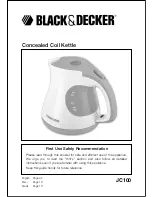
HD4666, HD4665, HD4603, HD4602
4222 001 97231
2
ENGLISH
Introduction
.
Dear customer, thank you for buying a Philips kettle. In these instructions for use you
will find all the information you need to enjoy your kettle as long as possible.
General description
.
1) On/off switch
2) Pilot light
3) Lid
4) Spout
5) Water-level indicator
6) Base
7) Scale filter
Important
.
Read these instructions for use carefully before using the appliance and save them for
future reference.
◗
Check if the voltage indicated on the base of the kettle corresponds to the
local mains voltage before you connect the appliance.
◗
Only use the kettle in combination with its original base.
◗
Always place the base and the kettle on a dry, flat and stable surface.
◗
Keep the cord, the base and the appliance away from hot surfaces.
◗
Do not use the appliance if the mains cord, the plug, the base or the appliance
itself is damaged.
◗
If the mains cord is damaged, it must always be replaced by Philips, a service
centre authorised by Philips or similarly qualified persons in order to avoid a
hazard.
◗
Do not immerse the appliance or the base in water or any other liquid.
◗
The kettle is only meant for boiling water. Do not use it to heat up soup or
other liquids or jarred, bottled or tinned food.
◗
Boiling water can cause serious burns. Be careful when the kettle contains hot
water.
◗
Never fill the kettle beyond the maximum level indication. If the kettle has
been overfilled, boiling water may be ejected from the spout and cause
scalding.
◗
Do not open the lid while the water is boiling. Be careful when you open the
lid immediately after the water has boiled: the steam coming out of the kettle
is very hot.
◗
Avoid touching the body of the kettle, as it gets very hot during use.Always lift
the kettle by its handle.
◗
Keep the appliance and its cord out of the reach of children. Do not let the
mains cord hang over the edge of the table or worktop. Excess cord can be
stored in or around the base of the appliance.
◗
Never fill the kettle below the minimum level to prevent the kettle from
boiling dry.
◗
HD4603 and HD4666: this rapid-boil kettle can draw up to 13 amps from the
power supply in your home. Make sure that the electrical system in your home
and the circuit to which the kettle is connected can cope with this level of
power consumption. Do not let too many other appliances draw power from
the same circuit while the kettle is being used.
◗
Some condensation may appear on the base of the kettle.This is perfectly
normal and does not mean that the kettle has any defects.
◗
Depending on the hardness of the water in your area, small spots may appear
on the heating element of your kettle when you use it.This phenomenon is the
result of scale build-up on the heating element and on the inside of the kettle
over time.The harder the water, the faster scale will build up. Scale can occur
in different colours.Although scale is harmless, too much scale can influence
the performance of your kettle. Descale your kettle regularly by following the
instructions given in the chapter 'Descaling'.
Boil-dry protection
This kettle is equipped with boil-dry protection.This device will automatically switch
the kettle off if it is accidentally switched on when there is no water or not enough
water in it.The on/off switch will stay in 'on' position and the pilot light, if available, will
stay on. Switch the kettle off and let it cool down for 10 minutes.Then lift the kettle
from its base to reset the boil-dry protection.The kettle is ready for use again.
Before first use
.
◗
Remove stickers, if any, from the base or kettle.
◗
Place the base on a dry, stable and flat surface.
◗
Adjust the length of the cord by winding it round the reel in the base. Pass the
cord through one of the slots in the base (fig. 2).
Before using the kettle for the first time:
1
Rinse the kettle with water.
2
Fill the kettle with water up to the maximum level and let it boil once (see
'Using the appliance').
3
Pour out the hot water and rinse the kettle once more.
Using the appliance
.
1
Fill the kettle with water either through the spout or through the open lid
(fig. 3).
2
3
4
5

































